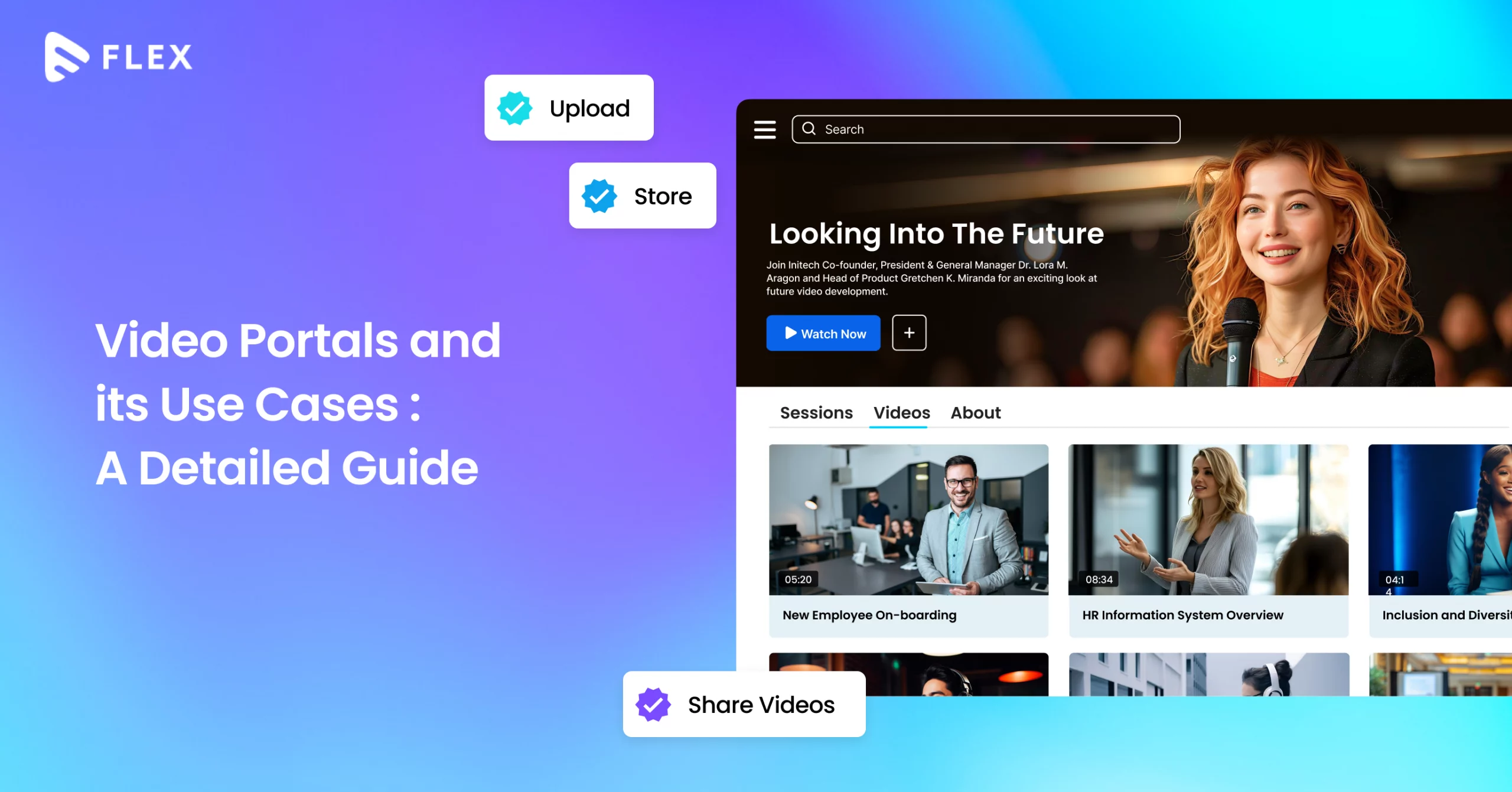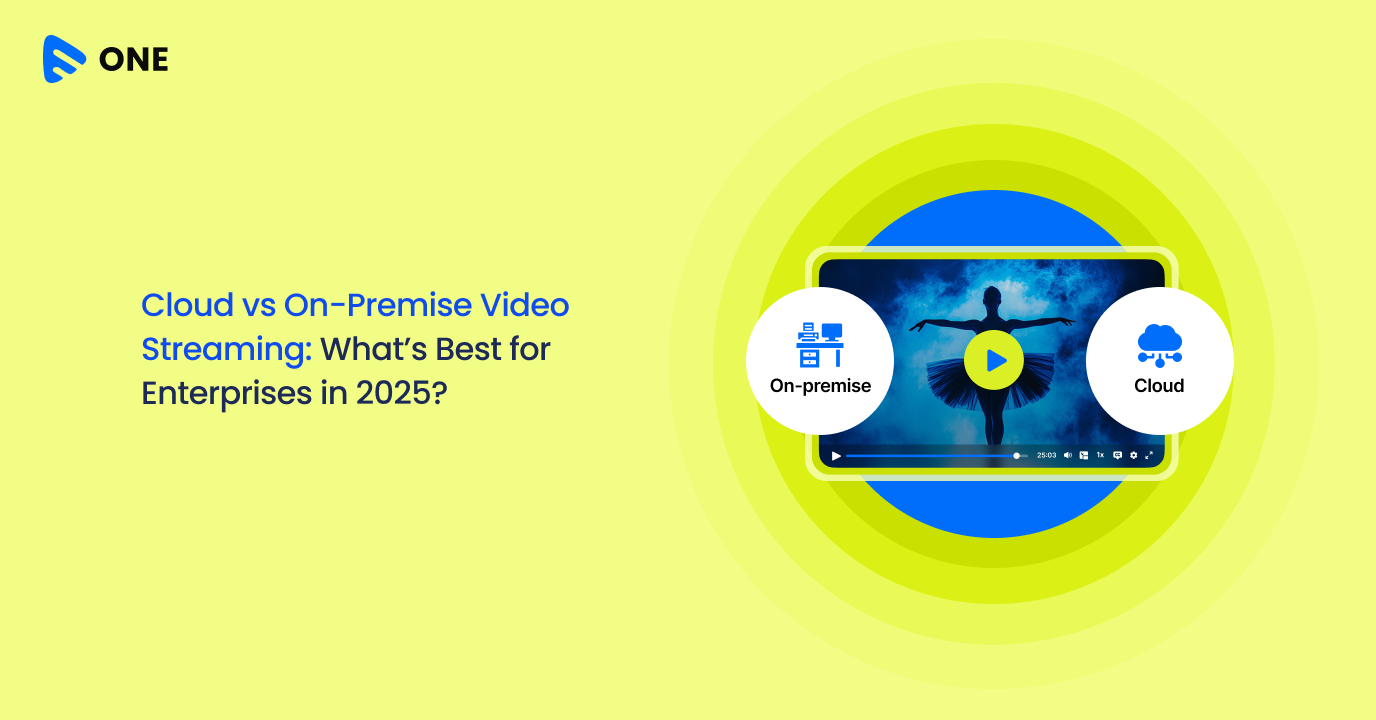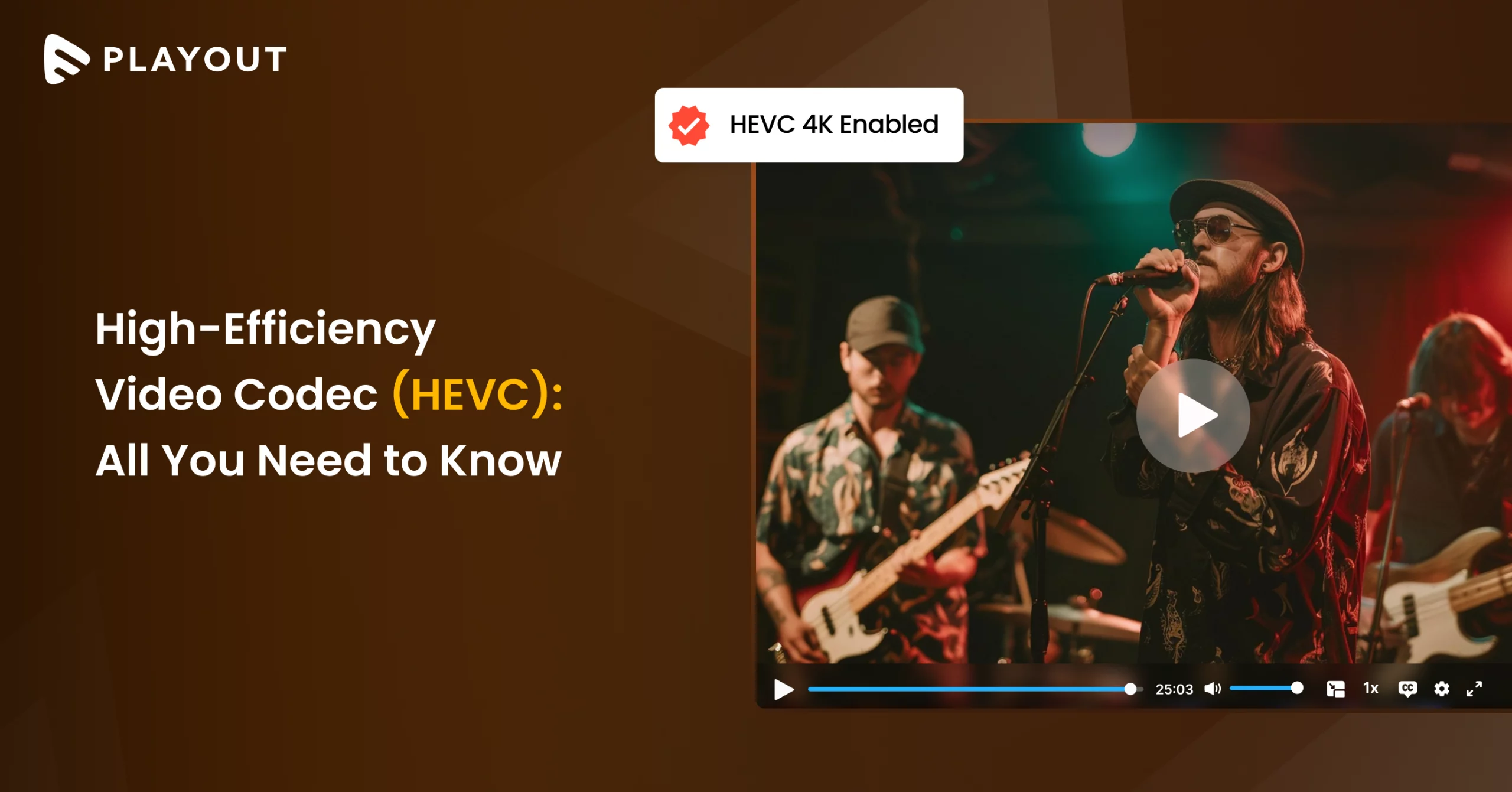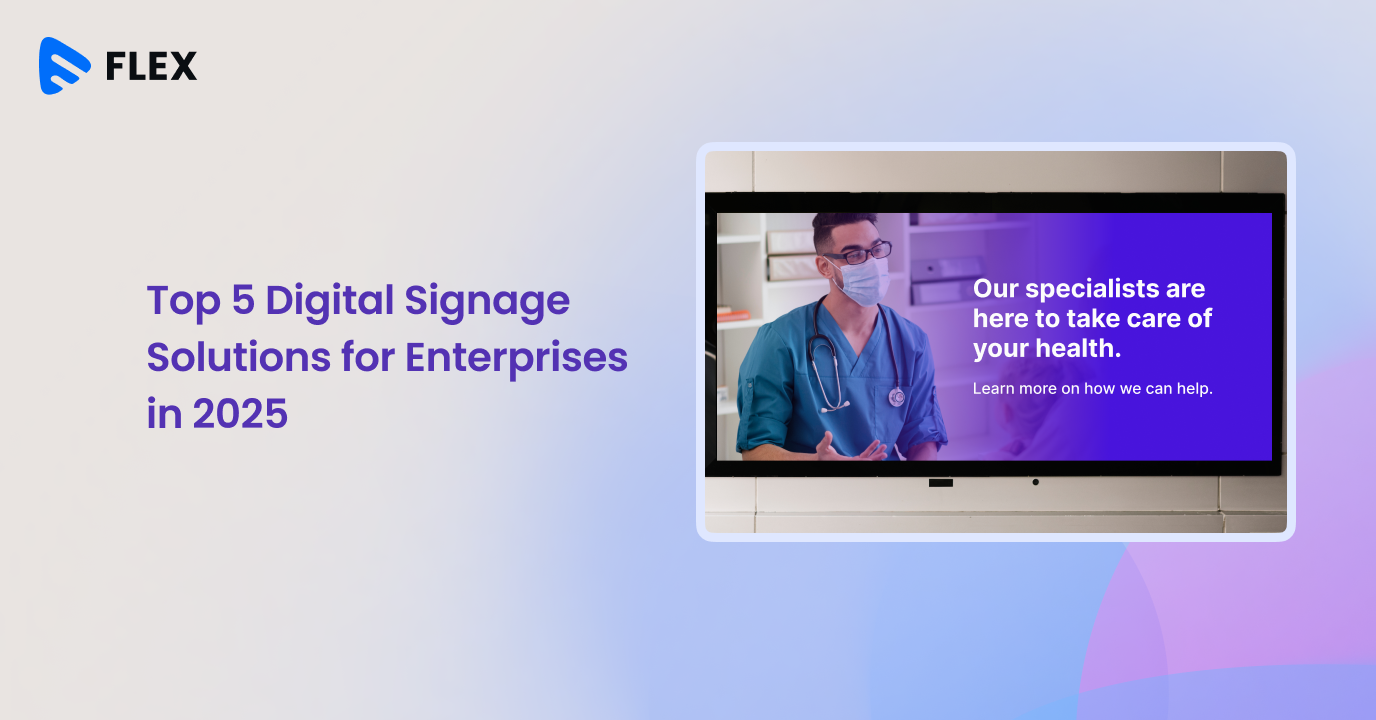A video portal allows end-users to upload, store, and share video files seamlessly. A video portal is not only a storage service but also an active ecosystem that will improve collaboration, streamline business workflows, and enhance user engagement.
If you are a business with employees that you need to train across several locations, you can make a set of training videos hosted on a secure and easy-to-navigate video portal. You can let employees access the content at their convenience, revisit sections as needed, and even interact with quizzes or comments to reinforce learning.
Video portals can also be used in educational institutions to revolutionize the way teaching and learning is perceived. Whether you want to streamline internal processes, deliver better customer experiences, or sort out your video assets for better organization, you’re just one step closer to it.
This guide is quite in detail and will walk you through what a video portal is, all the ways you might use it in various industries, and how it can revolutionize the way you handle video content.
What is a Video Portal?
A video portal allows users to host, store, and manage their video contents at one single location. They can then classify the videos into different categories and embed or share the same on their website, applications, and social media platforms.
Video portals generally ensure that video hosting, media storage, and management are efficient. The use of video portals enables businesses to be able to provide high-quality video and audio content directly from the desktop to a variety of devices for viewing with seamless, incredible quality, regardless of network bandwidth.
Different types of video portals
There are two types of video portals and these are:
✅External
✅Internal
External Video Portals
These are primarily shared and distributed for public viewing. Companies employ these to share videos such as product demos or else brand awareness videos that people across the globe can view directly or through links shared on socials. The only drawback of external video portals is that it is not as secure as an internal one because any person having the link to view the video can view it.
Internal Video Portals
Within an internal video portal, there is a need for the log-in then end-users can see the video content. In addition, owners are allowed describing for every video which exact person or group of people may view it.
Those who need to hold webinars meetings or else employee training, etc are best suitable with internal video portals.
Seamlessly Host, and Manage your video contents with Muvi Flex! The Need Of Video Portal Across Various Domains
Businesses
An enterprise video portal solution can help a company train employees at different locations. The organization can create a suite of training videos that live within a secure and user-friendly video platform. Employees can view content on their schedule; review specific segments as frequently as needed; and interact with quizzes or comments to make learning more effective.
In addition, the enterprise video portals can be applied for hosting meetings and webinars. By relying on video portals, businesses can better organize their communication processes while increasing their reach and making the general experience for the participants more enjoyable.
Organizations need a central video portal to:
✅Save: A Video Portal for Organization acts as a secure repository where all the videos created by an organization can be safely stored.
✅Sort: With a centralized portal, organizations can categorize videos by topics, departments, dates, or other relevant criteria.
✅Index: Indexing allows for the creation of metadata and tags associated with each video. This feature is essential for organizing the content
✅Search: A central video portal provides robust search functionality, enabling users to find specific videos quickly.
✅Manage: The video portal allows for the comprehensive management of video content, including editing, updating, or archiving videos as necessary.
✅Share: Finally, an enterprise video portal facilitates the easy sharing of videos both internally and externally. Whether distributing training videos across departments or sharing promotional content with clients, a centralized system simplifies the sharing process.
Educational Institutions
Changing the learning experience in educational institutions can be made through the use of a video portal. Lectures and tutorials uploaded by teachers will be made available for the students anytime, anywhere. This supports not only a blended learning model but also the varied pace and style of learning.
Educational institutions need a central video portal for:
✅Accessibility: Educational institutions can provide a single, easy-to-access platform where students, faculty, and staff can find all educational videos, lectures, and tutorials.
✅Content Organization: You can Streamline the storage and categorization of video content, making it easier to search and find out specific videos, course materials, and recorded sessions.
✅Collaboration and Sharing: Faculty members can easily share instructional videos, research presentations, and other educational content with colleagues and students.
✅Distance Learning: Provide a reliable platform for hosting live-streamed lectures, webinars, and virtual classrooms.
✅Analytics and Feedback: Collect data on video usage, viewer engagement, and learning outcomes.
Marketers and Content Creators
This makes video portals a form of distributed brand promotion content and leads to viewer engagement and the collection of analytics, which in turn informs future strategies for marketers and content creators. For example, the video portal enables the categorization of content, customization of playlists, and accessibility in controls in front of different users for greater flexibility on the part of the user.
The Need for a Central Video Portal for Marketers and Content Creators:
✅Categorization – A central video portal allows marketers and content creators to efficiently organize their video content by categories.
✅Customizable Playlists – Customizable playlists enable marketers and content creators to group videos according to specific themes or projects.
✅ User Access Controls –Users’ access to the video content is vital to maintaining their security and confidentiality. In most cases, marketers and content creators handle sensitive materials not everyone ought to access.
Centralized video portals centralize the management, distribution, and security of video content, thus becoming a very important piece of equipment for marketers and even content creators to streamline the managing of their video assets across different projects and teams.
Entertainment
✅Streaming Services for Movies and TV Shows: Video portals can host a wide range of entertainment content, allowing users to stream movies, TV series, and original content on demand.
✅Music Videos and Live Performances: Artists and bands can share music videos, live concert recordings, and exclusive performances with fans.
✅Gaming and eSports Content: Gamers can stream live gameplay, share tutorials, and broadcast eSports events, creating a vibrant community around gaming.
E-commerce
✅Product Demonstrations and Reviews: Sellers can upload video content that will show how products work, help to highlight features, and display customer reviews for use by the buyer to make decisions.
✅Live Shopping Events: Brands can broadcast live shopping events where viewers can see the product in use, allow them to ask real-time questions about the products, and make purchases through the broadcast of the event.
✅Customer Service and Support Videos: Companies can offer instructional videos on how to use products or troubleshoot common issues, enhancing customer support.
Real Estate
✅Virtual Property Tours: Real estate agents working for multi-platform property management company like airbnb management london can create, host and share video tours of properties on video portals, allowing potential buyers to explore homes and commercial spaces remotely.
✅Agent Introductions and Client Testimonials: Agents can introduce themselves and share testimonials from satisfied clients, building trust with prospective buyers and sellers.
✅Market Updates and Educational Content: With the help of video portals real estate agents can also share videos that provide updates on market trends, neighborhood insights, and tips for buying or selling property.
Sports and Fitness
✅Training Sessions and Workout Routines: Fitness professionals can manage workout videos, training tips, and exercise routines on video portals for viewers to follow along at home.
✅Live Sports Events and Highlights: Sports leagues and teams can broadcast live games, match highlights, and behind-the-scenes content to engage fans.
✅Fitness Challenges and Motivational Content: Fitness influencers and trainers can create and upload videos featuring challenges, success stories, and motivational messages to inspire their audience.
Healthcare
✅Telemedicine Consultations: Patients can consult with healthcare providers remotely through video calls, making it easier to access medical advice and follow-ups without needing to visit a clinic.
✅Health and Wellness Education: Medical professionals and health organizations can share informative videos about health tips, disease prevention, and wellness strategies.
✅Patient Support Groups and Counseling: Video portals can host support group meetings and counseling sessions for patients dealing with similar health conditions.
Benefits of Enterprise Video Portal Solution
Centralized Content Management
All video content can now be unified into a single platform called an enterprise video portal and made easier to manage, organize, and search for the videos-this is very useful for large organizations with high volumes of content.
Enhanced Collaboration and Communication
Video portals enhance communication between teams, departments, and global offices. Employees can easily create, upload, and share videos to facilitate knowledge transfer, training, and project collaboration.
Improved Training and Development
Video portals help ensure better teamwork coordination and maximum interaction among teams, departments, and different offices around the globe. The service easily allows employees to create, upload, and share videos in increasing efficient knowledge transfer, training, and sharing on any project.
Security and Privacy
The video portal can be used by companies for employee onboarding, Security Awareness Training, and as a means for continuous training and professional development. Learning with videos makes knowledge more memorable.
Analytics and Insights
Advanced video portal analytics offer insights regarding engagement, watch time, and content performance; hence, organizations can optimize their content strategy and develop videos that align with audience preferences.
Cost and Time Efficiency
Hosting the videos in-house saves costs incurred from third-party hosts; therefore, access to the video can be faster than other peoples’ expectations, and the bandwidth does not incur any costs. In addition, it reduces travel since the employees attend virtual meetings, training, and webinars based on recorded content.
Customization
Enterprises can customize their video portal to reflect their brand, creating a consistent experience for internal and external users. This can include branded themes, interfaces, and customized workflows.
Key Features to look in Video Portal Solution
Built-in CDN
A built-in CDN guarantees quick and effective delivery of video content to the viewer geographically anywhere. It reduces latency and buffering through delivery by using different servers which allow video playback with minimal lagging, even when there is high traffic.
Support for Various Video Streaming Formats
Look for a variety of formats, including MP4, WebM, and adaptive streaming formats like HLS and DASH. So compatible with so many devices and browsers, you are sure to enjoy it on any device with flexibility to view it anywhere, anytime.
Bulk Upload
The video portal chosen must have the feature of mass upload capability so that multiple videos can be uploaded at one go, saving a lot of time and efforts. For example, this feature is very useful for business or content producers who commonly deal with large video libraries where they can upload new content without much interference from them to upload each file because it would take too long.
Online Video Player
An online video player constitutes an important part of the user experience. Your video portal should be able to accommodate multiple formats and should embed easily on websites, while easy playback control should be user-friendly, with respect to both captioned closed captions and a customizable interface to drive branding.
Automatic Encoding and Transcoding
Recently, video files need to be encoded into several formats for compatibility on different devices as well as network conditions. Video encoding and transcoding must thus happen automatically in any video portal because otherwise, without it, one won’t use videos to be uploaded in an optimal format on any device without manual conversions.
Playlist with HLS Output
HLS is a widely used adaptive streaming format that offers high-quality video delivery. A playlist with HLS output allows you to create a series of videos that can be streamed in a way that adjusts to the viewer’s internet speed, ensuring smooth playback even in low-bandwidth environments.
Built-in DRM
You must prioritize a secured video hosting solution. Built-in DRM in your video portal protects video content from unauthorized access or piracy. This feature ensures that only authorized users can view or download the content, which is crucial for businesses, educators, or content creators who want to protect their intellectual property.
Social Publishing
Social publishing integration lets the published video content be easily posted on numerous social media channels directly from the video portal. It increases reach, involvement, and traffic back to the source of the content.
Analytics
Analytics tools will help you give insight into how viewers behave, video performance, and engagement. Metrics such as view count, watch time, the geographic location, device type, and also points of drop-off help you understand the efficiency of the video content and enables data-driven decisions in improving them from the next rendition.
Conclusion
Muvi Flex is a secure video portal that helps you seamlessly host, embed, share and manage videos with enterprise-grade security and scalability. With the help of Muvi Flex, you can deliver high-quality video and audio contents across various devices and thus provide your audience an unmatched viewing experience.
With customization, multi-platform compatibility, integration capabilities, security measures, and analytics insights, Muvi Flex empowers you to deliver an exceptional streaming experience to your users. Start your free trial now!















Add your comment